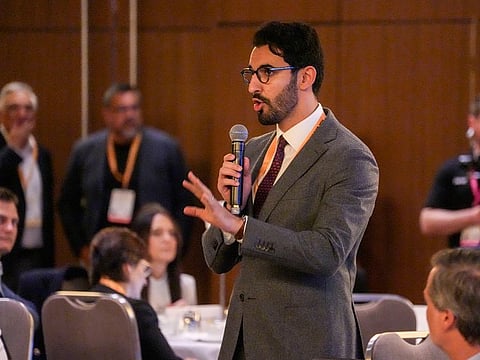Saudi Arabia will focus on high-spending India, Chinese tourists, says Deputy Tourism Minister
Kingdom wants to create new base of high spending international visitors

Perth: Saudi Arabia’s tourism focus will soon extend to high-spending visitors from India and China, according to a top government official.
The Kingdom is exploring the inclusion of more countries in its e-visa program, which currently covers 63 nations, including China.
“We're not just bringing in tourists - we want visitors who contribute meaningfully to the economy,” said Sultan Al Musallam, Saudi Arabia's Deputy Minister of Tourism for International Affairs.
The Gulf economy has revised its target for international visitors from 100 million annually to 150 million by 2030. This is where the focus on China, India and other sourcing markets will be crucial. KSA achieved the 100 million visitor target in 2023, seven years ahead of schedule.
Growth potential
“While seeing growth from European markets, particularly in leisure tourism, the East holds enormous opportunities,” said Al Musallam. “The booming middle-income segment presents a huge opportunity in India. Indian tourists are evolving—they’re no longer just exploring neighbouring destinations but venturing further, which benefits us.”
Traditionally, India has a strong flow of traffic through visiting friends and relatives to Saudi Arabia, driven by a large expatriate population and religious tourism. “We’re collaborating with the Indian government to expand beyond VFR and attract more affluent tourists seeking new experiences,” the minister added, who is optimistic about a rebound in Chinese tourism as well.
“We’re witnessing double-digit growth in interest from European tourists who want to experience what the Kingdom has to offer - and we’re banking on that,” he said.
The Ministry wants to increase the share of international tourists versus its domestic numbers. Last year, Saudi saw 77 million domestic tourists and 27 million international travellers, totalling 104 million visitors. And domestic visitor spending grew by 21.5% to SR142.5 billion.
“We aim to have a 50-50 mix of international and domestic tourists by 2030,” said Al Musallam.
‘Numbers speak for themselves’
Last year, Saudi Arabia's tourism sector surged over 32%, contributing SR444.3 billion to GDP. “The share of leisure tourists among inbound visitors is continually rising,” said Al Musallam.
The sector's GDP contribution was 3.5% in 2019. “We aim to be 10% (of GDP) by 2030, and we are on track. Construction is booming across Saudi Arabia, with new hotels rapidly emerging,” the minister said.
“For instance, we had one Four Seasons hotel in the Kingdom for 30 years, and five more will open in the next two to three years.”
According to World Travel & Tourism Council, jobs supported by the tourism sector grew by 436,000, reaching over 2.5 million, which accounts for nearly one in five jobs in Saudi Arabia.
Will supply meet demand?
When asked whether demand is outpacing supply, Musallam said, “So far, we don’t see any issues. However, we need to maintain this pace and hope that demand continues to grow as supply enters the market.”
The government is advancing several giga and mega projects, including Neom, Red Sea, Qiddiya, Roshn, Diriyah, and New Murabba, as well as airports to accommodate the rising number of tourists.
Regarding construction acceleration, Al Musallam said, “This is already happening in the Red Sea, where many resorts are open or set to open soon. The St. Regis, Ritz-Carlton, and Six Senses are operational, with more on the way next year.”
“The Red Sea International Airport is currently operating, and Neom will feature its international airport connecting to various countries beyond Saudi Arabia.”
“The King Abdulaziz Airport in Jeddah has been completely renovated; it's essentially been constructed from scratch. King Salman Airport, which is under construction, will be the largest of its kind. Riyadh Air plans to inaugurate its first flights by 2025," he said.
Status of giga projects
Al Musallam highlighted that multiple giga and mega projects are progressing well. “Some projects are already completed. For instance, Sindalah Island, part of the Neom project, will welcome guests this year. The Bab Samhan Hotel in Diriyah is now open, and the Bujairi Terrace is welcoming visitors to Riyadh.
“We are not just stating our intentions; we are actively making progress.”
Foreign investment
The minister noted a growing interest from foreign investors in Saudi Arabia. “The Hyatt Group held its first-ever board meeting outside the US in Saudi last month, demonstrating their view of Saudi not just as a market but as a partner in their growth story,” he said.
“We also see interest from hotel groups in India, China, and Thailand. The Minor Group has already visited Saudi, translating into projects, joint ventures, and direct investment in hospitality and tourism.”
GCC-wide visa to revolutionise regional travel
The GCC-wide tourism visa is under discussion among the Ministries of Interior to finalize the implementation mechanism. “However, I cannot provide a timeline for when this will happen, as it is not within our mandate as tourism ministers,” said Sultan Al Musallam. “We are collaborating with partners in Bahrain, Qatar, Oman, the UAE, Jordan, and Egypt to create diverse routes and programs catering to various tourist interests.”
Sign up for the Daily Briefing
Get the latest news and updates straight to your inbox



